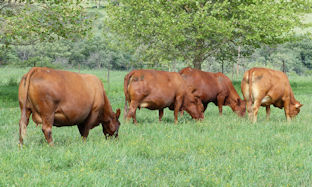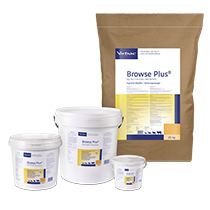
BEEF COW MANAGEMENT PRE CALVING: Nutrition & Body Condition Score
This is article 2 of 7 articles on this topic
The last two months before calving is probably one of the most important periods in the production cycle to ensure success.
This not only affects the successful birth of a calf with a strong survivability, but also what happens to the calf and the cow after the birth process, to the success of the coming breeding season and even up to and including weaning time. The following aspects should receive attention:
Body Condition and Nutrition
It is well known that cows must calve in an acceptable condition score, as it has such a large effect on many aspects that affect production, reproduction and ultimately profitability. A condition score of 3.5 with calving is generally considered ideal (See photos).
It is important to start early with extra supplementation, if cows' condition is not as desired as condition can not be increased overnight! So, start earlier rather than later to improve the condition of cows. Very important - do not let the long winter coat fool you and overestimate condition!
The nutrition / condition of the cows before / during calving is of cardinal importance for the following reasons:
- Development of the unborn calf:
We know that most fetal growth (+-75%) takes place in the last two months of pregnancy. The feeding of the cow during this time must be able to support the proper development the unborn calf AND maintain or increase the condition of the cow. This will benefit the viability of the new born calf - especially during inclement weather conditions at birth.
Although not a common problem, over conditioning during this time can be detrimental. This can lead to an increase in the birth weight of the calves, so that problems with difficult births may occur. - Influence on the number of days to first heat after calving, re-conception and intercalving period:
Cows should be in the ideal condition against calving to reduce the number of “open days” between calving and conception, and to ensure a good re-conception. See in Table 1 what the effect of condition score with calving is on the time when the cows are “infertile” - ie before they start to cycle. The earlier cows start to cycle and become successfully fertilized, the better (shorter) their intercalving period will be.
Table 1: Influence of condition score with calving on number of “infertile” days after calving (Kunkle et al, 1998)
- Influence on udder development, colostrum quality and milk production:
Nutrition in late gestation has a direct influence on udder development. Udder development again has an influence on colostrum production (quantity and quality), as well as milk production during lactation. NB. All three of these aspects can not be corrected by good feeding conditions after calving!
Table 2: Influence of condition with calving, on the quality of colostrum - as measured in the serum of calves, 24 hours after birth (Odde, 1992)
The quantity and quality of the colostrum can play a decisive role in calf survival after birth. Calves need to get enough colostrum to provide them with important nutrients. In addition, the quality must be such that the calves ingest enough antibodies to get their immune system going and improve calf survival.
With a well-developed udder and with the right condition (nutrition), the cow will be able to produce maximum milk. In the first two months, calves are exclusively dependent on the cow's milk before their intake of grazing becomes significant. At this time, their feed conversion ratio is also the best (1:1 to 2:1), and an optimal growth rate at this early stage can have a positive effect on weaning mass. (Table 3).
Table 3. Influence of condition score with calving on 240 day weaning mass (Houghton et al, 1990)
KT @ CALVING
240 DAY WEANING MASS (kg)
2
170
2.5
209
3
234
3.5
234
With all the above in mind, it is imperative the nutrition of cows that have a body condition score of 3 to 2.5 or less, 8 weeks before the calving season, needs to be drastically adjusted - especially if there are not yet good grazing conditions (quality and quantity), or prospects for it. The provision of good quality hay or silage, and/or a production lick can help to improve their condition.
6009230802DVN


